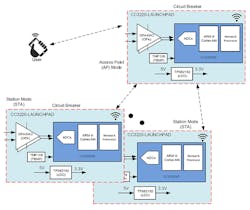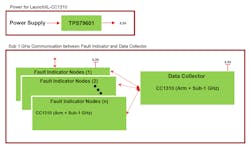Wireless Makes the Electric Grid Smarter and More Reliable
Download this article in PDF format.
The electric grid in the United States is over 130 years old. Yet it continues to supply electricity reliably via over 3200 electric utility companies. This dated infrastructure has its problems, but it’s gradually undergoing a transition that will improve its reliability and make it less subject to fossil-fuel usage.
The goal is to create a “smart grid” that will rely more on renewable energy, distributed microgrids, and incorporate modern technologies to improve its ability to supply our ever-increasing demand for electricity. One of those technologies is wireless communications. Some of the wireless developments include connected meters, efficient distribution, smart EV charging, and data on demand. Short-range wireless devices are proving themselves as a way to improve the system in multiple ways.
Sponsored Resources:
- Modernize the grid to make it more resilient and reliable
- Grid IoT Reference Design: Connecting Circuit Breakers and Sensors to Other Equipment Using Wi-Fi
- Grid IoT Reference Design: Connecting Fault Indicators, Data Collector, Mini-RTU Using Sub-1 GHz RF
Appreciating the Electric Grid
An electric grid is a network of power-generating stations, transmission lines, substations, distribution lines, transformers, and customer equipment that provides ac power to factories, homes, and businesses. We usually think of electrical power as being delivered by our local electric utility. Actually, though, it’s a massive system of utilities that are interconnected to create a grid not only to supply power to a specific area, but also to share power or borrow power depending on seasonal or weather changes.
The U.S. grid is made up of five regional systems: The Eastern Grid, Western Grid, the Texas Grid, the Quebec Grid, and the Alaska Grid. The Eastern and Western systems are the largest. Their power is typically synchronized to 60 Hz to make sharing possible. The systems contain hundreds of thousands of miles of high-voltage transmission lines and millions of miles of local distribution lines, plus all of the transformers and related protective gear.
The constant challenge when it comes to the grid is load balancing. Since ac electrical power can’t be stored, it must be used as generated. If not used, it’s essentially wasted. At other times, the usage is too great and exceeds system capacity. It’s at that point when grids share power. Alternative energy sources like wind and solar offer storage capabilities in the form of batteries that can supply power when there’s no wind or sunshine. However, at the end of 2018, the U.S. Energy Information Administration says that today only about 17% of electrical power comes from renewable sources—about half that for wind and 1.6 % solar. But those figures are growing.
Today, the main objective is to morph the current grid into an updated smart grid that incorporates more alternative renewable-energy sources as well as remote monitoring and control communications capability that can reduce power outages and energy (fuel) usage, as well as provide increased security. Wireless can help.
The Wireless Solution
The responsibility of the grid is to keep the power flowing by reducing the downtime caused by faults in the system. Power outages are inconvenient for customers and wasteful and inconvenient for the power companies. The solution lies in quicker identification of faults and faster corrective action. Wireless sensors and actuators can provide that solution.
System operators must deal with a variety of power-distribution problems caused by circuit breakers, switch gear, protection relays, transformers, current-limiting reactors, surge arresters, motors, controllers, and other essential components. By adding sensors to the system, operators can quickly identify the troublesome device or faulty equipment. This way, the sooner it can be reset, repaired, or replaced.
In the past, much of the corrective solutions involved human interaction. Today, more and more, these repairs can be automated. An example is a circuit breaker that previously had to be manually reset can now be reset remotely.
Wireless links between sensors and actuators plus a monitoring and control facility can provide early warnings of faults, resulting in action that restores power sooner. This wireless capability enhances most networks that today continue to rely on legacy wired networks like SCADA (supervisory control and data acquisition).
But that’s not all. Wireless technology has gradually been deployed to automatically meter energy usage at businesses and homes. Smart meters transmit their home readings wirelessly to a gateway back to the utility. Again, wireless technology can improve service by detecting down time and automatically determine electrical power needs.
Wireless Choices
A number of wireless technologies are adaptable to power-grid application. These include Bluetooth, Zigbee, Wi-Fi, sub-1-GHz ISM band radios, and others. Two that show superior characteristics for this application are Wi-Fi and sub-1-GHz ISM band radios.
Wi-Fi
Wi-Fi is familiar and has proven itself over the years as a reliable system. It’s easy to establish a new network and/or connect to an existing Wi-Fi network. Wi-Fi chips today are small and consume minimal power, making them suitable for use in sensors as well as access points.
One Wi-Fi device that fits this application is Texas Instruments’ CC3220. It’s fully certified by the Wi-Fi Alliance for interoperability. This single-chip SimpleLink device incorporates an Arm Cortex-M4 that’s programmed to fit the application. It includes power-saving modes and security features. For example, in an always-connected beacon mode, the device only draws a current of 700 µA. Intermittent connections only draw 3 mA for a 5-second interval or 1.5 mA for a 10-second interval. A hibernate mode takes a mere <10 µA.
As for security, the SimpleLink chip uses a 128-bit unique device ID, secure boot of MCU image, internal HTTPS server for AP provisioning, MQTT over TLS, and secure over-the-air update.
TI offers a complete Reference Design for this WI-Fi system. Designated as the TIDA-010007, this reference design will let you evaluate its capability as well as speed up and simplify your design. It will show you how to integrate Wi-Fi in grid equipment to monitor asset health, perform predictive maintenance, and minimize power disruptions.
1. On top is an Internet of Things (IoT) solution using access points (APs) connected to the cloud for an improved grid using Wi-Fi. In the bottom illustration, the devices serve as their own APs.
Figure 1 shows two Wi-Fi operational scenarios. In the application on top, Wi-Fi access points (AP) are used to interface to the sensors and controlled devices. Some links are direct, but others take place through the internet. The second scenario uses the devices themselves as APs.
Sub-1-GHz ISM Band Radios
Another wireless option is Texas Instruments’ CC1310 SimpleLink radio that includes an ARM Cortex-M3 MCU (Fig. 2). It’s used in applications where the data transmitted is shorter in duration but over an extended distance. This radio operates in the industrial, scientific, and medical (ISM) license-free bands, 315-468 MHz or 769-935 MHz. A common application is to collect data from fault passage indicators (FPI) or fault indicators (FI) that help to determine the location of a fault. General data collection is also a common use. Up to nine FPI nodes may be connected using this device.
2. Fault-indicator nodes transmit their status back to a central data collector for decision-making and action using the sub-1-GHz ISM band transceivers.
The CC1310 is IEEE 802-15-4 compatible. It’s designed to transmit short packets (<300 bytes) at 50 kb/s. With transmit power in the 0- to 10-dBm range distances of up to 50 meters can be reached. The CC1190 range extender radio is available to increase communications distances. Typical beacon intervals are 0.3 and 5 seconds. A reference design is also available for this device (TIDA-00816).Sponsored Resources:
About the Author

Lou Frenzel
Technical Contributing Editor
Lou Frenzel is a Contributing Technology Editor for Electronic Design Magazine where he writes articles and the blog Communique and other online material on the wireless, networking, and communications sectors. Lou interviews executives and engineers, attends conferences, and researches multiple areas. Lou has been writing in some capacity for ED since 2000.
Lou has 25+ years experience in the electronics industry as an engineer and manager. He has held VP level positions with Heathkit, McGraw Hill, and has 9 years of college teaching experience. Lou holds a bachelor’s degree from the University of Houston and a master’s degree from the University of Maryland. He is author of 28 books on computer and electronic subjects and lives in Bulverde, TX with his wife Joan. His website is www.loufrenzel.com.



